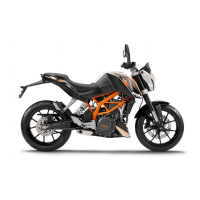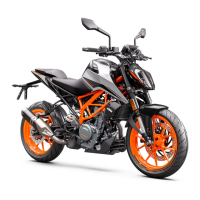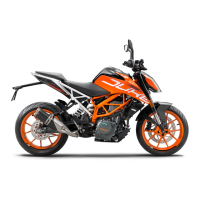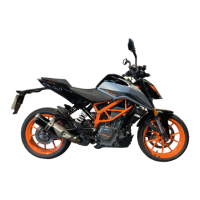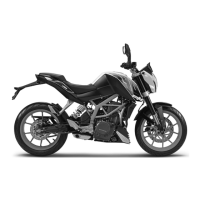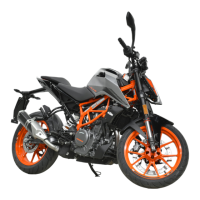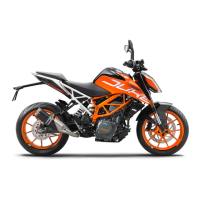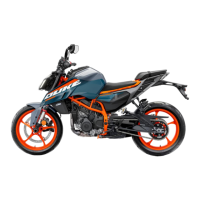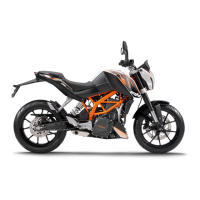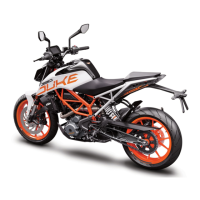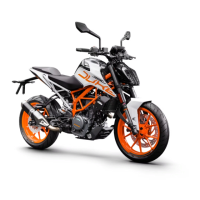Do you have a question about the KTM 390 Duke EU and is the answer not in the manual?
The meaning of specific symbols used in the manual.
Explanation of typographical formats used in the manual.
Defines the intended use of the motorcycle for regular road operation.
Details what constitutes misuse and potential dangers.
General instructions for safe operation and importance of labels.
Explanation of danger levels (Danger, Warning, Caution, Note) and symbols.
Prohibitions related to tampering with the noise control system.
Crucial safety advice for operating the motorcycle responsibly.
Importance of wearing appropriate protective clothing for safety.
General rules and conditions to follow when performing work on the vehicle.
Guidance on responsible use and disposal to protect the environment.
Emphasizes reading the manual carefully for operation and maintenance.
Conditions for warranty validity and exclusions for tampering/conversions.
Notes on fuel quality, handling, and environmental hazards.
Advice on using approved spare parts and accessories.
Importance of proper service for operation and wear prevention.
Note that figures may depict special equipment and might be disassembled.
Information on contacting KTM dealers for support.
Diagram showing the front left view with numbered motorcycle components.
Diagram showing the rear right view with numbered motorcycle components.
Location of the vehicle identification number (VIN) stamped on the steering head.
Location of the motorcycle's type label on the frame.
Location of the engine number stamped on the engine.
Information on the key number and KEYCODECARD for replacement keys.
Description of the clutch lever on the left handlebar.
Description of the hand brake lever on the right handlebar.
Description of the throttle grip on the right handlebar.
Details combination switch, light, menu, turn signal, and horn buttons.
Details Emergency OFF and Start buttons.
Location and function of the ignition and steering lock.
Instructions for locking the motorcycle's steering.
Instructions for unlocking the motorcycle's steering.
Procedure for opening the fuel tank filler cap with safety notes.
Procedure for closing the fuel tank filler cap with safety notes.
Location and operation of the seat lock.
Location of the tool set under the passenger seat.
Description and function of the motorcycle's grab handles.
Description of the passenger foot pegs.
Location of the shift lever on the engine.
Location and use of the foot brake lever for the rear brake.
Location and function of the side stand.
Covers instrument activation, display, modes, warnings, and indicator lamps.
Explains speed, ODO, coolant temp, fuel level, time, and favorites displays.
Details Quick Selectors, menu structure, and device pairing (phone, headset).
Covers audio, telephony, general info, trips, warnings, ABS, and settings.
Covers safety, clothing, tires, and initial checks before riding.
Guidance on engine speed limits and throttle use during the running-in phase.
Warnings on vehicle loading, weight limits, and luggage security.
Pre-ride checks for oil, brakes, tires, electrical system, and luggage.
Procedure for starting the engine, including safety notes.
Steps for engaging gear, releasing clutch, and applying throttle.
Advice on gear shifting, speed adaptation, and passenger safety.
Techniques for braking, ABS, engine braking, and stopping distance.
Instructions for stopping, parking, and locking the steering.
Notes on securing the motorcycle for transport.
Procedure for refueling, including safety and fuel quality notes.
Notes on service intervals, local conditions, and up-to-date schedules.
Detailed list of mandatory maintenance tasks and their intervals.
List of recommended maintenance tasks and their intervals.
Procedure for adjusting shock absorber preload for optimal handling.
How to adjust the shift lever for comfortable operation.
Steps for safely lifting the rear of the motorcycle.
Procedure for safely removing the motorcycle from the rear lifting gear.
Steps for safely lifting the front of the motorcycle.
Procedure for safely removing the motorcycle from the front lifting gear.
How to clean fork leg dust boots to maintain seal integrity.
Instructions for removing the passenger seat.
Instructions for mounting the passenger seat.
Instructions for removing the front rider's seat.
Instructions for mounting the front rider's seat.
How to check the chain for dirt and clean it.
Detailed steps for cleaning the motorcycle chain.
How to check and the importance of correct chain tension.
Procedure for adjusting the chain tension to the specified measurement.
How to check wear on chain and sprockets and when to replace.
How to adjust the clutch lever for comfortable reach.
Explanation of the ABS system, its function, and warnings.
How to adjust the hand brake lever for comfortable reach.
How to check brake disc thickness, damage, and cracking.
Procedure for checking the front brake fluid level.
Procedure for adding front brake fluid, including safety precautions.
How to check the minimum thickness of front brake linings.
How to check the free travel of the foot brake lever.
Procedure for adjusting the free travel of the foot brake lever.
Procedure for checking the rear brake fluid level.
Procedure for adding rear brake fluid, including safety precautions.
How to check the minimum thickness of rear brake linings.
Step-by-step guide for removing the front wheel.
Step-by-step guide for installing the front wheel.
Step-by-step guide for removing the rear wheel.
Step-by-step guide for installing the rear wheel.
How to check and replace rear hub damping rubber pieces.
How to check tires for cuts, damage, tread depth, and age.
Procedure for checking and correcting tire pressure.
Information on the DRL function, activation, and legal regulations.
Safety precautions and steps for removing the 12-V battery.
Steps for installing the 12-V battery and connecting terminals.
Guidance on charging the 12-V battery, including safety.
Procedure for changing the main fuse, located under the seat.
How to locate and change the ABS fuses.
Procedure for changing fuses for various electrical components.
Procedure for checking and adjusting the headlight beam alignment.
Procedure for adjusting the headlight range.
Location of the diagnostics connector for fault reading.
Location of front power supplies ACC1 and ACC2.
Location of rear power supply ACC2.
Overview of the cooling system components and function.
Procedure for checking coolant level and antifreeze protection.
Procedure for checking coolant levels in tank and radiator.
Procedure for draining the motorcycle's cooling system.
Procedure for filling and bleeding the cooling system.
Procedure for changing the motorcycle's coolant.
How to check and adjust the free travel of the clutch lever.
Procedure for adjusting the clutch lever play.
How to check the engine oil level when the engine is at operating temperature.
Procedure for changing engine oil, filter, and cleaning oil screens.
Procedure for adding engine oil, with notes on quality and mixing.
Detailed instructions for cleaning the motorcycle, including safety.
Advice on preparing for winter storage and protection against salt.
Steps for preparing the motorcycle for long-term storage.
Steps to take the motorcycle out of storage and prepare it for riding.
Lists common faults, their possible causes, and recommended actions.
Specifications for the engine, including displacement, bore, and stroke.
List of torque specifications for various engine components.
Details on engine oil, coolant, and fuel tank capacities.
Technical data for chassis, brakes, and suspension.
Specifications for battery, fuses, and lighting systems.
Specifications for the front and rear tires.
Specifications for the front fork, including oil type and quantity.
Specifications for the shock absorber.
Torque specifications for chassis mounting bolts and nuts.
Specifications and recommended suppliers for brake fluid.
Specifications and recommendations for coolant and antifreeze.
Specifications and recommended suppliers for engine oil.
Specifications for fork oil.
Fuel specifications for Gasohol 95 E20.
Fuel specifications for Super unleaded (ROZ 95).
Fuel specifications for Super unleaded, type C.
Recommended chain cleaner product.
Recommended fuel additive product.
Recommended long-life grease product.
Recommended motorcycle cleaner product.
Recommended paint care products.
Recommended products for preserving materials.
Recommended special cleaner product.
Recommended street chain spray product.
Recommended universal oil spray product.
Explanation of the JASO T903 MA2 standard for motorcycle oils.
Explanation of SAE viscosity classes for oils.
Definition of Anti-lock braking system.
Definition of Daytime Running Light.
Definition of the system for wireless communication.
Definition of On-board diagnosis system.
Indicate error conditions requiring immediate intervention.
Indicate errors needing prompt intervention or active driving aids.
Reflect general information and status indicators.
The meaning of specific symbols used in the manual.
Explanation of typographical formats used in the manual.
Defines the intended use of the motorcycle for regular road operation.
Details what constitutes misuse and potential dangers.
General instructions for safe operation and importance of labels.
Explanation of danger levels (Danger, Warning, Caution, Note) and symbols.
Prohibitions related to tampering with the noise control system.
Crucial safety advice for operating the motorcycle responsibly.
Importance of wearing appropriate protective clothing for safety.
General rules and conditions to follow when performing work on the vehicle.
Guidance on responsible use and disposal to protect the environment.
Emphasizes reading the manual carefully for operation and maintenance.
Conditions for warranty validity and exclusions for tampering/conversions.
Notes on fuel quality, handling, and environmental hazards.
Advice on using approved spare parts and accessories.
Importance of proper service for operation and wear prevention.
Note that figures may depict special equipment and might be disassembled.
Information on contacting KTM dealers for support.
Diagram showing the front left view with numbered motorcycle components.
Diagram showing the rear right view with numbered motorcycle components.
Location of the vehicle identification number (VIN) stamped on the steering head.
Location of the motorcycle's type label on the frame.
Location of the engine number stamped on the engine.
Information on the key number and KEYCODECARD for replacement keys.
Description of the clutch lever on the left handlebar.
Description of the hand brake lever on the right handlebar.
Description of the throttle grip on the right handlebar.
Details combination switch, light, menu, turn signal, and horn buttons.
Details Emergency OFF and Start buttons.
Location and function of the ignition and steering lock.
Instructions for locking the motorcycle's steering.
Instructions for unlocking the motorcycle's steering.
Procedure for opening the fuel tank filler cap with safety notes.
Procedure for closing the fuel tank filler cap with safety notes.
Location and operation of the seat lock.
Location of the tool set under the passenger seat.
Description and function of the motorcycle's grab handles.
Description of the passenger foot pegs.
Location of the shift lever on the engine.
Location and use of the foot brake lever for the rear brake.
Location and function of the side stand.
Covers instrument activation, display, modes, warnings, and indicator lamps.
Explains speed, ODO, coolant temp, fuel level, time, and favorites displays.
Details Quick Selectors, menu structure, and device pairing (phone, headset).
Covers audio, telephony, general info, trips, warnings, ABS, and settings.
Covers safety, clothing, tires, and initial checks before riding.
Guidance on engine speed limits and throttle use during the running-in phase.
Warnings on vehicle loading, weight limits, and luggage security.
Pre-ride checks for oil, brakes, tires, electrical system, and luggage.
Procedure for starting the engine, including safety notes.
Steps for engaging gear, releasing clutch, and applying throttle.
Advice on gear shifting, speed adaptation, and passenger safety.
Techniques for braking, ABS, engine braking, and stopping distance.
Instructions for stopping, parking, and locking the steering.
Notes on securing the motorcycle for transport.
Procedure for refueling, including safety and fuel quality notes.
Notes on service intervals, local conditions, and up-to-date schedules.
Detailed list of mandatory maintenance tasks and their intervals.
List of recommended maintenance tasks and their intervals.
Procedure for adjusting shock absorber preload for optimal handling.
How to adjust the shift lever for comfortable operation.
Steps for safely lifting the rear of the motorcycle.
Procedure for safely removing the motorcycle from the rear lifting gear.
Steps for safely lifting the front of the motorcycle.
Procedure for safely removing the motorcycle from the front lifting gear.
How to clean fork leg dust boots to maintain seal integrity.
Instructions for removing the passenger seat.
Instructions for mounting the passenger seat.
Instructions for removing the front rider's seat.
Instructions for mounting the front rider's seat.
How to check the chain for dirt and clean it.
Detailed steps for cleaning the motorcycle chain.
How to check and the importance of correct chain tension.
Procedure for adjusting the chain tension to the specified measurement.
How to check wear on chain and sprockets and when to replace.
How to adjust the clutch lever for comfortable reach.
Explanation of the ABS system, its function, and warnings.
How to adjust the hand brake lever for comfortable reach.
How to check brake disc thickness, damage, and cracking.
Procedure for checking the front brake fluid level.
Procedure for adding front brake fluid, including safety precautions.
How to check the minimum thickness of front brake linings.
How to check the free travel of the foot brake lever.
Procedure for adjusting the free travel of the foot brake lever.
Procedure for checking the rear brake fluid level.
Procedure for adding rear brake fluid, including safety precautions.
How to check the minimum thickness of rear brake linings.
Step-by-step guide for removing the front wheel.
Step-by-step guide for installing the front wheel.
Step-by-step guide for removing the rear wheel.
Step-by-step guide for installing the rear wheel.
How to check and replace rear hub damping rubber pieces.
How to check tires for cuts, damage, tread depth, and age.
Procedure for checking and correcting tire pressure.
Information on the DRL function, activation, and legal regulations.
Safety precautions and steps for removing the 12-V battery.
Steps for installing the 12-V battery and connecting terminals.
Guidance on charging the 12-V battery, including safety.
Procedure for changing the main fuse, located under the seat.
How to locate and change the ABS fuses.
Procedure for changing fuses for various electrical components.
Procedure for checking and adjusting the headlight beam alignment.
Procedure for adjusting the headlight range.
Location of the diagnostics connector for fault reading.
Location of front power supplies ACC1 and ACC2.
Location of rear power supply ACC2.
Overview of the cooling system components and function.
Procedure for checking coolant level and antifreeze protection.
Procedure for checking coolant levels in tank and radiator.
Procedure for draining the motorcycle's cooling system.
Procedure for filling and bleeding the cooling system.
Procedure for changing the motorcycle's coolant.
How to check and adjust the free travel of the clutch lever.
Procedure for adjusting the clutch lever play.
How to check the engine oil level when the engine is at operating temperature.
Procedure for changing engine oil, filter, and cleaning oil screens.
Procedure for adding engine oil, with notes on quality and mixing.
Detailed instructions for cleaning the motorcycle, including safety.
Advice on preparing for winter storage and protection against salt.
Steps for preparing the motorcycle for long-term storage.
Steps to take the motorcycle out of storage and prepare it for riding.
Lists common faults, their possible causes, and recommended actions.
Specifications for the engine, including displacement, bore, and stroke.
List of torque specifications for various engine components.
Details on engine oil, coolant, and fuel tank capacities.
Technical data for chassis, brakes, and suspension.
Specifications for battery, fuses, and lighting systems.
Specifications for the front and rear tires.
Specifications for the front fork, including oil type and quantity.
Specifications for the shock absorber.
Torque specifications for chassis mounting bolts and nuts.
Specifications and recommended suppliers for brake fluid.
Specifications and recommendations for coolant and antifreeze.
Specifications and recommended suppliers for engine oil.
Specifications for fork oil.
Fuel specifications for Gasohol 95 E20.
Fuel specifications for Super unleaded (ROZ 95).
Fuel specifications for Super unleaded, type C.
Recommended chain cleaner product.
Recommended fuel additive product.
Recommended long-life grease product.
Recommended motorcycle cleaner product.
Recommended paint care products.
Recommended products for preserving materials.
Recommended special cleaner product.
Recommended street chain spray product.
Recommended universal oil spray product.
Explanation of the JASO T903 MA2 standard for motorcycle oils.
Explanation of SAE viscosity classes for oils.
Definition of Anti-lock braking system.
Definition of Daytime Running Light.
Definition of the system for wireless communication.
Definition of On-board diagnosis system.
Indicate error conditions requiring immediate intervention.
Indicate errors needing prompt intervention or active driving aids.
Reflect general information and status indicators.
| Brand | KTM |
|---|---|
| Model | 390 Duke EU |
| Category | Motorcycle |
| Language | English |
